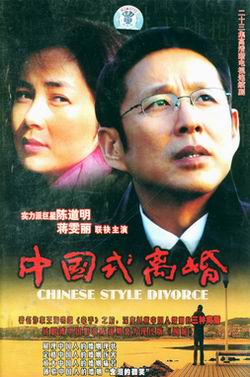Divorce rise, reforms linked
(Xinhua)
Updated: 2006-06-24 09:29

A poster of the TV
series Divorce, Chinese-Style. It ran nightly for 23 episodes last
year and was extremely popular. It is adapted from a novel of the same
name by Chinese famous woman writer Wang Hailing. The author depicts
the joys and sorrows, partings and reunions within Chinese family life.
The huge success of the series reflects the growing importance of divorce
as a social phenomenon in China during social and economic reforms. In
the past years, more than 1.5 million Chinese couples divorced
annually. [baidu.com] | One side effect of
China's reforms and more mobile society is a rising divorce rate, a government
report said.
A report issued by the Ministry of Civil Affairs said the divorce rate has
been on the rise since 2002. A total of 1.785 million couples divorced in 2005,
120,000 more than the previous year, leading to a divorce rate of 2.73 per
thousand.
Chen Rongzhi, a scholar with the Overseas Chinese University in south China's
Fujian Province, attributed the rise to the itinerant population.
"A great floating population occurs as people in rural areas move to cities
and between cities for higher incomes, leading to more diversity among marriage
partners," said Chen. "A family member's migration creates greater chances to
disrupt the stability of a family and a marriage," she said.
"China's traditional ideas are giving way to new ones, such as Internet
dating, onenight stands, or quick marriages," said a report by Tang Can, a
scholar with Chinese Academy of Social Sciences.
Tang described these new phenomena as the young generation's pursuit of
"sensuous satisfaction" so they treated marriage less seriously than their
parents, which tended to drive up the divorce rate.
However, the rising divorce rate reflected a positive side too, Chen said, as
the freedom to marry or divorce showed a more tolerant social atmosphere and
respect for individuals.
Families have undergone great changes in the last two decades. An aging
society put much pressure on families to take elderly relatives under the
present social security system, and the one-child policy altered the traditional
multi-children family structure, said Chen.
(For more biz stories, please visit Industry Updates)
|